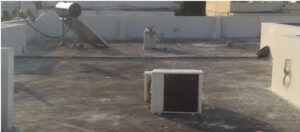 Concrete roofing is an increasingly popular choice in Australia due to its extreme durability and fire resistance. It also requires less maintenance than other roofing materials, such as metal or tiles, which means it can be a cost-effective option for many homeowners.
Concrete roofing is an increasingly popular choice in Australia due to its extreme durability and fire resistance. It also requires less maintenance than other roofing materials, such as metal or tiles, which means it can be a cost-effective option for many homeowners.
In ths article, we’ll explore some of the advantages and disadvantages of a concrete roof in Australia so you can decide if it is the right choice for your home.
Advantages
Here are 10 advantages of a concrete roof in Australia
Insulation
Concrete roofs offer excellent insulation, keeping your home much cooler in the summer and warmer in the winter. This can help lower energy costs over time and make your home more comfortable year-round.
Soundproofing
Concrete has soundproofing qualities, which can block out a great deal of noise from outside sources like traffic and airplanes. This makes it an ideal roofing material if you want to keep unwanted noises at bay in your home. The soundproofing qualities also provide a great level of privacy from your neighbors.
Durability
Concrete roofs are incredibly durable, lasting up to 50 years, or sometimes even longer. The material is resistant to all types of weather conditions including high winds and hail, as well as extreme temperatures. This makes it a great choice for those who want their roof to last the test of time without needing costly repairs or replacements.
Fire Resistance
The fire-resistant properties of concrete make it an ideal material for roofing purposes. Not only can it withstand direct exposure to flames, but it won’t burn and won’t release toxic fumes if exposed to intense heat. This makes it a good choice for those who want to protect their home from potential fires.
Maintenance
Concrete requires little maintenance, as it doesn’t require regular cleaning like asphalt or tile roofs do. Minor repairs may be needed occasionally but overall the material is extremely low-maintenance compared to other roofing materials.
Energy Effeciency
Concrete roofs can help keep your home cool during the summer months, due to their reflective properties. This means less energy is needed to maintain a comfortable temperature indoors. Furthermore, concrete is highly insulating and can help reduce heat loss in winter, meaning your heating bills may be lower compared with other roofing materials.
Design Flexibility
With modern construction techniques, concrete can be molded into various shapes and sizes, providing a wide range of design possibilities. It can also be finished in many ways to achieve different aesthetics. For example, concrete tiles can be made to mimic the look of more traditional roofing materials, like clay, slate, or wood.
Wind and Storm Resistance
Due to their weight and strength, concrete roofs have excellent resistance to wind uplift and can withstand severe storm conditions, making them a good choice in hurricane-prone areas.
Sustainability
Concrete is often made from abundant natural materials, making it a sustainable choice. Furthermore, at the end of its life, concrete can be crushed and recycled for use in new construction projects.
Disadvantages
This type of roofing comes with an array of disadvantages, including
1. Weight
One of the most significant challenges with concrete roofs is their weight. Concrete is heavy, which means the building’s structure must be strong enough to support it. If you’re considering a concrete roof for an existing building, you may need to reinforce the structure, which can add to the cost and complexity of the project.
2. Installation and Cost
 Concrete roofs can be more expensive and time-consuming to install compared to other roofing materials. The process often requires skilled labor, which can add to the overall cost. Also, due to the weight of concrete, the transportation and handling costs can be higher.
Concrete roofs can be more expensive and time-consuming to install compared to other roofing materials. The process often requires skilled labor, which can add to the overall cost. Also, due to the weight of concrete, the transportation and handling costs can be higher.
3. Maintenance
While generally low maintenance, when issues do occur, they can be challenging and costly to fix. For example, if a concrete tile cracks, it often needs to be replaced entirely. It’s also worth noting that although concrete itself is durable, the material used to seal the concrete may need periodic reapplication.
4. Weathering and Aging
Over time, concrete roofs can show signs of weathering. They may change color due to exposure to the elements, and in some climates, moss and lichens can grow on them, which may not be aesthetically pleasing to some homeowners.
5. Water Absorption
Concrete is porous, so it can absorb water if not properly sealed. This can lead to dampness issues and, in freezing conditions, can cause damage due to the freeze-thaw cycle.
6. Limited Insulation
While concrete roofs have excellent thermal mass, their insulation properties are not as high. Depending on the climate, additional insulation might be required, adding to the cost.
Despite these potential drawbacks, many people find that the advantages of concrete roofs outweigh the disadvantages, particularly in terms of their durability, longevity, and aesthetic appeal. It’s important to consider all factors and consult with a professional to make the best decision for your particular situation.